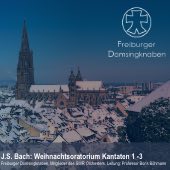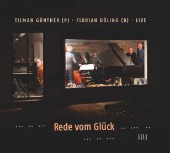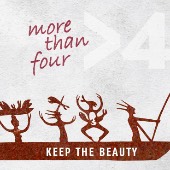Exemplary excerpts of Qmc Productions
Every production is unique and different from the others. Through a careful thought-out selection of pieces, we develop a music and sound concept together with the musicians and turn ideas into perfect reality. The aesthetic of the sound thereby follows the nature and the soul of the music. The spectrum reaches from entrapping and transporting the intimacy of a whisper, highly emotional and fragile, to a "forte fortissimo" of a symphony orchestra played in the cathedral.
Freiburg Cathedral Boys' Choir, members of the SWR Orchestra
Ines Bergks, Ursula Eittinger, Bernhard Gärtner, Wolfgang Newerla, Music Director Prof. Boris Böhmann
J.S. Bach, Christmas Oratorio, Cantatas 1 - 3
Few musical works are as festive and joyful as the Christmas Oratorio by Johannes Seabstian Bach. Shining trumpets and timpani triumph over the darkness of the night, gentle strings and sweet wood announce the quiet birth of Jesus.
Boris Böhmann prepared the choir for this work in the best possible way, and for the performance in Freiburg Minster with its incredible, but also long, reverberation time, he chose a very good line up and perfect tempi.
The best possible translation of the performance to a recording that conveys the Christmas atmosphere in stereo, surround and as part of a video was meticulously planned in advance so that only minimal adjustments were necessary in the mix.
A main microphone based on a Decca Tree was used for this purpose. By using special microphones - with extremely light titanium diaphragms and special directional characteristics - it was possible to ensure a very high level of audibility and greatly reduce the use of spot microphones. The breathtaking reverberation was recorded separately using a special microphone technique called Hamasaki Square. Here, four microphones with a special directional characteristic do not record direct sound, but only the reverberation of the cathedral. These four signals can also be used excellently in a surround or Atmos setups. The aim was to fully preserve the mood, the drama and the complexity and to immerse the listener in the Christmas atmosphere of Freiburg Minster.
Tilman Günther, Florian Döling
Rede vom Glück - Live
The two jazz musicians Tilman Günther and Florian Döling have been playing together for about 25 years now. You can hear and feel this familiarity that has been built up over this long period of time. This album is something very special: On the one hand it contains with only two exceptions exclusively original compositions, on the other hand the intimacy of the concert in the Black Forest is wonderfully captured with historic microphones and the latest recording technology. The two musicians are touching with their lyrical phrasing, their interplay and the successful compositions. The creaking and groaning of the double bass is palpable, and the dark, warm overall sound is literally illuminated by the impressive solo passages of Tilman Günther on the grand piano. Rarely has such a small intimate cast conveyed so much fun and deep joy.
More Than Four
Keep The Beauty
Keep the Beauty is a very special album. Inspired by the beauty of our earth, the band composed 15 wonderful tracks that reflect the beauty and diversity of our earth in their range between jazz, lyricism and world music. In every moment you can feel the organic sound of the acoustic instruments and the musicians' interplay and joy of playing. A special highlight are the lyrical interludes of Petra Gack, who weaves wonderful texts into the music with a very clear, dynamic and accentuated voice.
During the recording and mixing, great attention was paid to the sound of the album, in order to capture the joy of playing, the high dynamics and the naturalness on the CD, while perfectly resolving all the fine structures of the accoustical instruments.
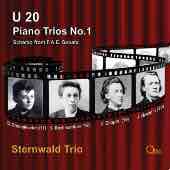
Sternwald Trio
Schostakovich, Rachmaninov, Chopin, Brahms - Piano Trios No.1 & Scherzo from F.A.E. Sonata
Under the motto “U 20”, the Sternwald trio presents brilliant youthful works by Shostakovich, Rachmaninov, Chopin and Brahms with breathtaking esprit and clarity. Immediately at the beginning, the listener is cast under his spell with the highly emotional piano trio of the 17-year-old Shostakovich, who was employed as a cinema pianist at the time. The first piano trio by the young Rachmaninov shows an equally strong cinematic and stage-like character, in which, in addition to the astonishing variety of timbres, he also seems to conjure up the sonority of an entire symphony orchestra.
In contrast to this, Chopin's trio follows with its virtuoso pearly lightness and dance-like elegance. The Sternwald Trio puts this little-known work by the young Chopin in the limelight and convinces with a noble and masterfully differentiated interpretation.
The Sternwald Trio brings an unexpected enrichment to the repertoire with their own arrangement of the Brahms Scherzo from the F.A.E. Violin sonata, in which both the dramatic and the symphonic quality of this gripping youthful work is wonderfully brought to bear by the expanded cast.
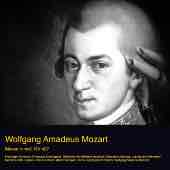
Freiburger Domkapelle & Domchor, Members of the Philharmonic Orchestra Freiburg
Sabine Goetz, Eleonora Vacchi, Hans-Jörg Mammel, Wolfgang Newerla, Music Director Prof. Boris Böhmann
Mozart, C-Minor Mass, KV 427
The C minor mass is special in many ways. A torso full of puzzles and full of great music. It is considered a monumental work, although like his Requiem it is unfinished. It is a hymn to death and life. Musically, too, there are musical peaks and contrasts. The fugues in Gloria and Sanctus show the extent to which Mozart filled the contrapuntal style influenced by Bach with his own spirit. Sabine Goetz interprets the incomparable soprano aria “Et incarnatus est”, which he composed for his wife Constanze, wonderfully. The large-scale system and the double-choir sections find their equivalent in the recording.
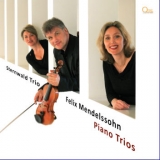
Sternwald Trio
Felix Mendelssohn, Piano Trios
Both of Mendelssohn's piano trios, set up and structured in a classical way, are not only great works of art, but were, in their time, anticipated by the stars of the music world such as Robert Schumann, greeted with enthusiasm. The emotional works are interpreted with an impressive firework of dynamics and tempi. The Sternwald Trio's astonishing degree of virtuosity, combined with their intimate circle of trust and ability to empathize with each other, brings out the passion of a work written by a man who wanted to express his feelings connected to the word friendship. We focused on the natural balance and the homogeneous connection of the instruments in the sound aesthetics, and feel you can hear their honesty.
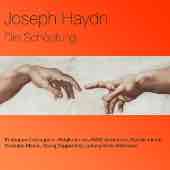
Freiburg Cathedral Choir & Cathedral Chapel, Members of the SWR Orchestra
Maraile Lichdi, Christian Elsner, Georg Zeppenfeld, Music Director Prof. Boris Böhmann
Joseph Haydn, The Creation
Have you ever pondered mankind’s relation to God? In Haydn's work, for large choir and symphony orchestra, the composers explicit stipulation thereof becomes clear as mankind's positive connection to God rises as the central theme, and delicate motives, alternate with astonishing, beaming moments thereafter. A perfect paradise. Haydn, himself, spoke openly about the religious experience he had while composing "the creation". His version of John Milton's epos "Lost Paradise" allows the choir to give a beautiful statement of praise. The Southwest German Orchestra simply shines in their instrumental performance together with soloists - baritone, Mr. Zeppenfeld, and tenor, Mr. Elsner - demonstrating refined phrasing and brilliant technique. They show us a perfect world, and stand out as a counterpoint to the otherwise impending chaos that existed before divine intervention prevailed.
Freiburg Cathedral Choir, members of the Freiburg Philharmonic Orchestra, Music Director Prof. Boris Böhmann
Tomoko Maria Nishioka, Ursula Eittinger, Prof. Reginaldo Pinheiro, Christoph Stephinger,
Gioachino Rossini, Stabat Mater
The middle aged prayer is well known for it’s touching expression of a mother’s painful loss of her crucified son, and has, set to music, a far deeper impact. It was through the various forms Rossini applied, such as aria, duet, quartet and choir, operatic arioso style, and austere a capella style and the combination there of, that his work received the recognition it deserved and was soon in a category of it's own. Composed for large symphony orchestra, recorded in Freiburg’s cathedral, whose building substance dates back to 1140 a.d., also known as the "Cathedral of Our Lady", it seems Stabat Mater found, 800 years later, the ideal acoustic and optimal setting to emphasize Maria’s sorrow.
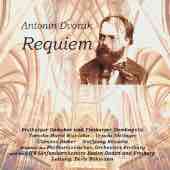
Freiburg Cathedral Choir & Cathedral Chapel, members of the Freiburg Philharmonic Orchestra & the SWR Orchestra
Tomoko Nishioka, Ursula Eittinger, Clemens Bieber, Wolfgang Newerla , Music Director Prof. Boris Böhmann
Antonin Dvorák, Requiem
The uniqueness of Dvoraks requiem may be explained by the fact that he had no particular motive, no special occasion in mind while composing. Yet it has, despite it's concertantes approach, an unbelievable universal expressive power. Dvorak was a master in articulating a differentiated instrumental musical sound. The fundamental idea of reintroducing a theme to found a close connected created context within a piece stems from symphonic praxis. This idea takes on poetic stature in Dvorak's requiem, and gives the work a deep meaning on another level: The guiding theme exposed in the first tacts permeates the whole work, underlining and enhancing the requiems main subject: death. Capturing the dynamical moments performed from over 200 musicians up on stage in Freiburg's cathedral gave us goose bumps. And still does.
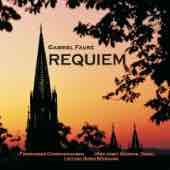
Freiburg Cathedral Boys' Choir Boys Choir, Jörg Schwab (organ), Music Director Prof. Boris Böhmann
Antonin Gabriel Fauré, Requiem
The Freiburger Domsingknaben Boys Choir is famous for their pure, brilliant sound, and belongs to the best in the world. They possess a radiance, a glow within that sparks in Fauré’s finster setting of a requiem, and then spreads like a force going through the inseparable ambivalence between sorrow and loss on one hand, hope and redemption on the other. Composed specifically for “Boys Choir” Fauré‘s Requiem was recorded in Freiburg’s cathedral, where we captured the earth shaking, majestic 32 foot register of the organ (Kontrafagott und Grand Bourdon) with frequencies as low as 16 Hertz. This requiem was also produced as a reference surround recording, allowing listeners to emerge themselves, to dive into this deeply emotional music. You can download a preview on the left side.
© 2024 | Qmc - the quiet music company | info@the-quiet-music.company | Impressum
© 2024 | Qmc - the quiet music company | info@the-quiet-music.company
© 2024 | Qmc | mail





